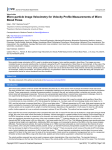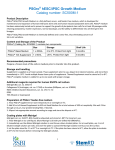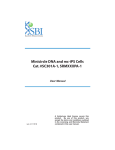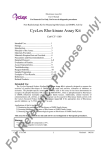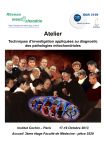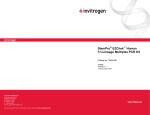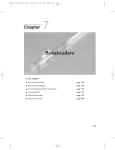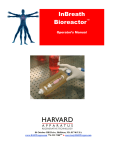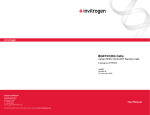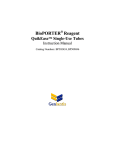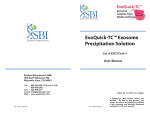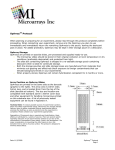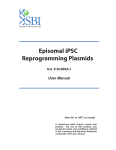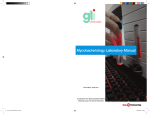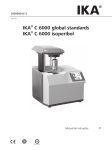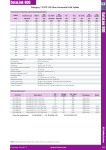Download User Manual
Transcript
Stem Cells Stem Cell Culture Maintenance of hESCs and hiPSCs in NutriStem® hESC XF media media Technical Manual NutriStem® hESC XF Medium, contains HSA Xeno-free medium for feeder-free and feeder-dependent culture of hESCs and hiPSCs Cat. No.: 05-100-1B 100ml Cat. No.: 05-100-1A 500ml AF NutriStem® hESC XF Medium, without HSA Xeno-free medium for feeder-dependent culture of hESCs and hiPSCs Cat. No.: 05-102-1B 100ml Cat. No.: 05-102-1A 500ml Version I- 03/2012 2 1. Introduction 2. Media and Reagents for Feeder-Free Culture Systems 2.1 NutriStem® hESC XF Medium 2.2 Freezing Medium: CryoStem 2.3 BD Matrigel™ (protocol for 1:40 dilution) 3. Methods for Feeder-Free Culture Systems 3.1 General Information 3.1.1 Observing Cultures Under the Microscope 3.2 Coating Plates with Matrigel™ 3.3 Thawing hESCs or hiPSCs on Matrigel™ using NutriStem® hESC XF Medium 3.4 Maintenance of hESCs or hiPSCs on Feeder Cells 3.4.1 Feeding hESCs or hiPSCs using NutriStem® hESC XF Medium 3.4.2 Removing Differentiated Cells from hESC or hiPSC Cultures 3.4.3 Passaging hESCs or hiPSCs using NutriStem® hESC XF Medium 3.5 Cryopreservation of hESCs or hiPSCs 4. Media and Reagents for Feeder-Dependent Culture Systems 4.1 NutriStem® hESC XF Medium and AF NutriStem® hESC XF Medium 4.2 MEF Medium 4.3 Collagenase IV Solution (1mg/ml) 4.4 Freezing Medium: CryoStem 5. Methods for Feeder-Dependent Culture Systems 5.1 General information 5.1.1 Observing Cultures Under the Microscope 5.2 Preparation of Feeder Cell Layer 5.3 Thawing Procedure for hESCs or hiPSCs on Feeder Cells using NutriStem® hESC XF Medium 5.4 5.4.1 Maintenance of hESCs or hiPSCs on Feeder Cells using NutriStem® hESC XF Medium Feeding hESCs or hiPSCs using NutriStem® hESC XF Medium 5.4.2 Removing Differentiated Cells from hESC or hiPSC Cultures 5.4.3 Passaging hESCs or hiPSCs using NutriStem® hESC XF Medium 5.5 Cryopreservation of hESCs or hiPSCs 5.6 Transferring hESCs or hiPSCs in NutriStem® hESC XF Medium from Feeders to a Feeder-Free Culture 6. Adaptation to NutriStem® hESC XF Medium 6.1 Adaptation Protocol – Direct and Gradual Adaptation Strategies 6.1.1 Direct Adaptation 6.1.2 Gradual Adaptation 7. References System 3 Stem Cell Culture 1. Introduction Traditional human embryonic stem cell (hESC) culture methods require the use of mouse or human fibroblast feeder layers, or feeder-conditioned medium. These culture methods are labor-intensive, hard to scale up, and it is difficult to maintain hESCs undifferentiated due to undefined conditions. NutriStem® hESC XF Medium was developed with a leading stem cell research group to enable the maintenance and expansion of hESCs with feeder cells or in feeder-independent culture. NutriStem® hESC XF Medium supports the culture of undifferentiated hESCs in serum-free conditions without any animal components on mouse feeder cells (MEFs), Matrigel™ or human foreskin fibroblasts (HFFs). The medium contains recombinant human basic fibroblast growth factor (rh bFGF) and recombinant human transforming growth factor β (rh TGFβ). The medium has been successfully tested and proven to maintain the pluripotentcy nature of hESCs. For long-term growth of hESCs without feeder cells the use of NutriStem® hESC XF Medium (with HSA) is recommended. Human embryonic stem cells (hESCs) must be monitored and cared for in order to maintain healthy, undifferentiated cultures. At the very least, the cultures must be fed every day by performing a complete medium change to replenish lost nutrients and keep the cultures free of unwanted differentiation factors. Although a small amount of differentiation is normal and expected in human embryonic stem cell culture, the culture should be routinely cleaned up by manually removing, or “picking” differentiated cells. Identifying and removing excess differentiation from hESC cultures are essential techniques in the maintenance of a healthy population of cells. • Serum-free media (SFM), xeno-free (XF): all components are defined and from Features non-animal origin, including proteins. • The proteins used are rh bFGF, rh TGFβ, human albumin, human transferrin and recombinant human insulin. • A complete ready-to-use formulation (no additions are required). • Contains alanyl glutamine. Does not contain antibiotics. • Enables culture of hESCs and hiPSCs with or without feeder cells. • Can be used with mouse or human feeder cells, Matrigel™ and with human cell matrices. • Intended for use with 5% CO2 (ordinary conditions). • Supports long-term growth of hESCs and hiPSCs, maintaining the ability to differentiate, without any signs of karyotype abnormalities. 4 2. Media and Reagents for Feeder-Free Culture Systems 2.1 NutriStem® hESC XF Medium (Cat# 05-100-1) Product Name Catalogue No. NutriStem® hESC XF Medium 05-100-1 CryoStem 05-710-1 DMEM/F12 (HAM) 1:1 01-170-1 NutriStem® hESC XF Medium is a ready-to-use medium and should be stored at -20°C. Thaw at room temperature or overnight at 2-8°C, and protect from light. Thawed NutriStem® hESC XF Medium is stable for 2 weeks when stored at 2-8°C. Dispense into aliquots to avoid repeated freezing and thawing; freeze/thawing more than 2 times is not recommended. NutriStem® hESC XF Medium must be warmed to room temperature or 37°C before use. To ensure the stability of the medium, warm only the required volume. 2.2 Freezing Medium 2.3 BD Matrigel™ (protocol for 1:40 final dilution) CryoStem, Cat# 05-710-1. Ready to use. BD Matrigel™ should be thawed on ice, aliquoted and refrozen. For full instructions and recommendations on aliquot size, please refer to the insert supplied with the product. Preparation of BD Matrigel™ Aliquots: 1. Thaw Matrigel™ on ice at 2-8°C refrigerator, overnight to avoid the formation of a gel. 2. Dilute BD Matrigel™ 1:1 with cold DMEM: F12 1:1 (Cat# 01-170-1). 3. Keep mixture on ice; mix well with a cold pipette. 4. Aliquot into pre-chilled 15ml tubes (for aliquot size, please refer to the insert supplied with the product). Store at -70°C. Stable for 6 months when stored at -70°C. 5 3. Methods for Feeder-Free Culture Systems 3.1 General Information • All solutions and equipment that come into contact with the cells must be sterile. Always use proper sterile techniques and work in a laminar flow hood. • hESCs and hiPSCs are very sensitive to quality of medium and solutions. Therefore, it is highly recommended to aliquot medium and solutions. • When working with hESCs or hiPSCs always pre-warm all the required solutions to room temperature or 37°C. 3.1.1 Observing Cultures under the Microscope Observe the plate under the microscope and assess the overall culture quality. Note the following: absence of any visible contamination, overall colony size, quality and density, and any other observations. hESCs and hiPSCs tend to create less rounded colonies on Matrigel™ in comparison to their morphology on feeder cells. In addition, the colonies are thinner and in some lines less condensed. Spontaneously differentiated cells may resemble cobblestones or trophoblast-like cells. The differentiated cells may reside at the colony perimeter or in the center of the colony. There can also be differentiated colonies containing large clumps of swirled tissue, or little balls of cells, like embryoid bodies. Different culture conditions yield different types of differentiated cells. 1. If the cultures do not require maintenance or passaging, they can be taken to the biological safety cabinet to be fed (see Section 3.4.1). 2. If the cultures contain more than 10% differentiating colonies, the cells should be “cleaned up” by manually removing the differentiated areas (see Section 3.4.2). 3. If the cultures contain large or dense colonies, the cells should be passaged (see Section 3.4.3). General Culture Handling Plan for Feeder-Free Culture in NutriStem® hESC XF Medium Cat# 05-100-1 Day Activity Day 1 Prepare Matrigel™-coated 6-well plate Passage hESCs Day 2 Feed the culture Day 3 Feed the culture Day 4 Feed the culture or Passage the culture if ready Day 5 Feed the culture or Passage the culture if ready Note: Perform a double volume feed on the weekend 6 Figure 1: Classical morphology, H1 hESCs in NutriStem® XF hESC Medium on Matrigel™ A B Sharp edge Condensed center A. Condensed colony with sharp edge; B. Colony with loose edges and condensed center Figure 2: Abnormal morphology of H1 hESCs cultured in feeder-free conditions 3.2 Coating Plates with Matrigel™ We recommend coating plates with BD Matrigel™. BD Matrigel™ should be thawed on ice, aliquoted and refrozen. For full instructions and recommendations on aliquot size, please refer to the insert supplied with the product. 1. Slowly thaw Matrigel™ aliquots on ice at 2-8°C refrigerator, to avoid the formation of a gel. 2. Dilute the Matrigel™ aliquots 1:20 in cold DMEM: F12 1:1. 3. Add 1ml of Matrigel™ solution to each well of 6-well plates. 4. Incubate the plates for at least 1-2 hours at room temperature or overnight at 2-8°C. Plates with Matrigel™ solution can be parafilm-sealed and stored at 2-8°C for one week. Do not use the plate if the Matrigel™ solution does not completely cover the surface. 5. Before use, warm to room temperature, remove Matrigel™ solution and wash the plate once with DMEM: F12 1:1. 7 3.3 Thawing hESCs or hiPSCs on Matrigel™ using NutriStem® hESC XF Medium Prior to thawing hESCs or hiPSCs, be sure to have a 6-well plate coated with Matrigel™. hESCs are usually cryopreserved from one nearly confluent well of a 6 well plate and intendent to be thawed into 1 well of 4 or 6 well plate. Thawing hESCs or hiPSCs 1. Add 5ml of warm NutriStem® hESC XF Medium into a 50ml conical tube. 2. Remove a cryogenic vial of hESCs from the liquid nitrogen storage tank. 3. Roll the vial between gloved hands for 3-5 seconds to remove the frost. 4. Record the information on the label of the vial. 5. Place the vial in a 37°C water bath; do not submerge the cap of the vial in the water as this could contaminate the cells. When only a small ice crystal remains, spray the entire vial with 70% ethanol for disinfection and wipe. 6. In a sterile biological safety cabinet, transfer the contents of the cryogenic vial drop by drop to the 5ml culture medium in the previously prepared 50ml conical tube. Gently rock to continually mix the cells as the new cell drops are added to the tube. 7. Centrifuge the cells for 5 minutes at 200xg. 8. While the hESCs are in the centrifuge, prepare the Matrigel™-coated plate by labeling with the appropriate hESCs information: cell line, passage number, and thawing date. Wash the wells; aspirate the Matrigel™ from the wells and add 1-2ml DMEM: F12 (1:1) per well. Gently swirl the medium around the well, aspirate and discard the medium. Add 1ml of NutriStem® hESC XF Medium. Plating the Thawed hESCs or hiPSCs Bring the pelleted hESCs back to the biological safety cabinet, and carefully aspirate the supernatant. Be careful not to aspirate the cell pellet, but remove as much supernatant as possible, as this solution contains DMSO. 9. Re-suspend the pellet very gently by adding 2ml of NutriStem® hESC XF Medium using a 5ml glass pipette and pipetting 3-4 times. 10. Slowly add the 2ml of hESC suspension to the prepared well in the 6-well plate. 11. Place the plate in the 37°C incubator and carefully slide the plate back and forth and side to side to evenly distribute the cells throughout the well. Do not swirl the plate in a circular pattern to avoid concentrating the colonies in the center. 12. Allow the cells to attach at 37°C and 5% CO2 overnight. 13. The day after thawing, remove the medium (with any floating cells) and add 3ml of fresh NutriStem® hESC XF Medium to the well. 8 Figure 3: hESC (H1 and hOct4-GFP reporter cells, invitrogen) frozen in CryoStem were thawed and cultured in NutriStem® hESC XF Medium on Matrigel™. H1 hESC BGO1V/hOG cells-Phase BGO1V/hOG cells-GFP 1 hr Postthawing Day 1 Postthawing Day 2-4 Postthawing Representative results for colony morphology of hESCs (H1 and BG01V) 1 hour, 1 day, and 2-4 days post-thawing. 3.4 Maintenance of hESCs or hiPSCs on Matrigel™ using NutriStem® hESC XF Medium 3.4.1 Feeding hESCs or hiPSCs using NutriStem® hESC XF Medium hESCs and hiPSCs require daily medium change for optimal growth. It is possible to perform a double volume feed on the weekend and the next medium change two days later. Skipping more than 1 day of medium change, or feeding the culture every other day continuously is not recommended. 1. Aspirate the spent medium. 2. Add the appropriate amount of warmed NutriStem® hESC XF Medium to each well. For cultures in a 6-well plate, add 3ml medium per well. 3. Incubate the plate at 37°C and 5% CO2. 9 3.4.2 Removing Differentiated Cells from hESC or hiPSC Cultures ¶ If the culture contains more differentiated colonies than “good” pluripotent colonies, picking only the “good” colonies is preferable. Change the medium to fresh prewarmed NutriStem® hESC XF Medium. 1. Aspirate the spent medium. 2. Add the appropriate amount of warmed NutriStem® hESC XF Medium to each well. For cultures in a 6-well plate, add 3ml medium per well. 3. Under the microscope, using a pipette tip, pick up as many good colonies as possible, leaving the differentiated colonies intact. 4. Transfer the supernatant medium containing the floating colonies to a new Matrigel™-coated plate. If the colonies are too big, pipette carefully up and down to break the colonies. Do not make the colony clumps too small. ¶ If the majority of the culture contains undifferentiated colonies and only some background differentiation, cleaning only the differentiated colonies is preferable. 1. Under the microscope, scrape off the differentiated areas using a pipette tip. 2. Aspirate the medium containing the floating differentiated cells. 3. Wash the well once with fresh warm DMEM: F12 (1:1). 4. Add the appropriate amount of warmed NutriStem® hESC XF Medium to each well. For cultures in a 6-well plate, add 3ml medium per well. 5. Incubate the plate at 37°C and 5% CO2. 3.4.3 Passaging hESCs or hiPSCs using NutriStem® hESC XF Medium Culture density is a critical aspect for maintaining healthy undifferentiated hESCs or hiPSCs in NutriStem® hESC XF Medium. Cultures that are either too sparsely or too densely populated can lead to differentiation. Passage times should be determined by colony size and density regardless of the number of colonies on the plate. Allowing colonies to get too large will result in differentiation. Colonies should not be allowed to reach a size or density high enough to touch one another for too long, as this will lead to increased differentiation. If the hESC culture reaches confluency, split within the next 24 hours. We recommend using Collagenase IV at 1mg/ml. If using other enzyme-based dissociation solutions (Dispase or Trypsin), optimal conditions should be determined by the user. This protocol is applicable when culturing hESCs on Matrigel™. 1. Aspirate the spent medium from the wells. 2. Wash the well once with warm DMEM: F12 (1:1). 3. Add 1ml per well of warmed Collagenase IV (1mg/ml). 4. Return the plate to the 37°C incubator. Check the culture every 5-10 minutes. Do not over-expose the cells to Collagenase IV. 10 5. Observe the colonies under the microscope. Incubate until the edges of the colonies begin to curl up but the colonies should remain attached to the plate surface. 6. Gently aspirate the Collagenase solution and wash at least once with DMEM: F12 1:1. 7. Add 2ml NutriStem® hESC XF Medium. 8. Gently scrape and wash off the well with a 5ml glass pipette while slowly releasing the NutriStem® hESC XF Medium. 9. Repeat the scraping and pipetting action 3-4 times until all the colonies have been removed from the well. Pipette gently to avoid breaking up the colonies into too small clumps. 10. Transfer the detached colonies into a clean sterile 50ml conical tube. 11. Use another 2ml of medium to wash the well. Transfer the contents into the same 50ml tube. Note: The split ratio of NutriStem® hESC XF Medium-based culture is usually 1:6-1:8 every 3-5 days. 12. To obtain the desirable split ratio, increase the volume of the colony suspension in the 50ml tube with NutriStem® hESC XF Medium accordingly (if the desired splitting ratio is 1:6, increase the medium to a final volume of 6ml, thus 6 new wells can be seeded). 13. Prepare a new Matrigel™-coated 6-well plate by labeling with the appropriate hESC information: cell line, passage number, and thaw date. Wash once with DMEM: F12 1:1. Gently add 2ml NutriStem® hESC XF Medium to each well to be seeded, and set the plate aside. 14. Pipette the hESC colony suspension gently in the tube to break up the colony clumps to the desired size. 15. Gently and evenly add 1ml of the suspended hESC clumps to each new well to be seeded. 16. Place the plate in the 37°C incubator and carefully slide the plate back and forth and side to side to evenly distribute the cells throughout the well. 17. Allow the colonies to attach at 37°C overnight. 18. Change the medium daily with fresh NutriStem® hESC XF Medium until the hESC colonies are large enough to passage. If the culture is at optimal density, the cells can be split every 3-4 days using a 1:6-1:8 splitting ratio. (Colonies from 1 well of a 6-well plate can be plated in 6-8 new wells of a 6-well plate). If the colonies are too dense or too sparse, adjust the splitting ratio accordingly. 11 Figure 4: Collagenase Type IV (1mg/ml) Treatment A B C A. H1 hESC culture ready for passage; B. Folding of the edges after Collagenase; C. Good sized clumps Figure 5: H1 hESC Colonies Development after Splitting A B C D A. Day 1 after split; B. Day 2 after split; C. Day 3 after split; D. Day 4 after split – ready for passaging. We recommend using CryoStem for the freezing of hESCs. CryoStem, the novel animal 3.5 Cryopreservation of hESCs or hiPSCs 12 component-free hESC freezing medium developed by Biological Industries contains no serum, but rather methylcellulose and DMSO. After freezing and thawing, a very high percentage of viable hESCs are obtained. In fact, comparative studies have shown that in most cases upon thawing and plating, higher viability and adhesion percentages are obtained in comparison with other freezing media formulations including serumcontaining freezing media. Features: • Chemically defined • Animal components-free (ACF) • Protein-free • For freezing hESCs or hiPSCs cultured in both feeder-free and feeder-dependent conditions • High recovery efficiency: maintains excellent attachment ability as well as growth performance • Maintains hESC and hiPSC pluripotency Freezing the hESCs or hiPSCs The following procedure is based on hESCs or hiPSCs cultured in 6-well plates where wells are 60-70% confluent at time of cryopreservation. Before cryopreservation, hESCs or hiPSCs should be of high quality (minimal differentiation – less than 10% of the culture). Note: The typical density for freezing hESCs is one well of cells (from a 6-well plate) per one cryogenic vial (freezing volume: 1ml of CryoStem freezing medium/vial). 1. Keep the cryogenic vial and the CryoStem freezing medium on ice until use. (It is recommended to aliquot the CryoStem freezing medium). 2. Prepare suspended hESC clumps by detaching the colonies to be frozen according to the protocol detailed in section 3.4.3 steps 1-11. 3. Centrifuge for 5 minutes at 200xg. 4. While the hESCs are in the centrifuge, label a cryogenic vial inside the biological safety cabinet, including the cell line, passage number and freezing date. 5. Aspirate and discard the supernatant from the pelleted hESCs, being careful not to disturb the loosely-packed colony pellet. 6. Re-suspend the colony pellet with 1ml of cold CryoStem per one well harvested (e.g., 6ml for freezing 6 wells of a 6-well plate). Be very gentle when pipetting, as hESCs recover better when frozen in relatively large colony pieces. 7. Quickly but gently add 1ml of the cell suspension to each cryogenic vial. 8. Transfer the vials into an isopropanol freezing container (e.g., Mr. Frosty), and place in a -80°C freezer overnight. The cells will freeze at 1°C per minute in the isopropanol freezing container. 9. The following day, quickly transfer the frozen vials to the liquid phase of a liquid nitrogen storage tank and record the vial position. 13 4. Media and Reagents For Feeder-Dependent Culture Systems 4.1 NutriStem® hESC XF Medium and AF NutriStem® hESC XF Medium (Cat# 05-100-1 and # 05-102-1) Product Name Catalogue No. NutriStem® hESC XF Medium 05-100-1 AF NutriStem® hESC XF Medium 05-102-1 Bio-Pure HSA 10% Solution 05-720-1 CryoStem 05-710-1 DMEM/F12 (HAM) 1:1 01-170-1 Certified FBS Qualified for hESC 04-002-1 DMEM HG 01-055-1 Alanyl-Glutamine 03-022-1 Sodium Pyruvate 03-042-1 0.1% Gelatin solution 01-944-1 NutriStem® hESC XF Medium and AF NutriStem® hESC XF Medium should be stored at -20°C. Thaw at room temperature or overnight at 2-8°C, and protect from light. Thawed NutriStem® hESC XF Medium is stable for 2 weeks when stored at 2-8°C. Dispense into aliquots to avoid repeated freezing and thawing; freeze/thawing more than 2 times is not recommended. NutriStem® hESC XF Medium must be warmed to room temperature or 37°C before use. To ensure the stability of the medium, only warm the amount needed. NutriStem® hESC XF Medium, Cat# 05-100-1, is ready-to-use. When using AF NutriStem® hESC XF Medium (Cat# 05-102-1) for feeder-independent culture, add 5% (v/v) of Bio-Pure HSA (Cat# 05-720-1) to the medium (0.5% (w/v) final): For example, 5.3 ml of Bio-Pure HSA, 10% solution to 100ml of AF-NutriStem® hESC XF. Bio-Pure HSA (Cat# 05-720-1) is a Xeno-Free supplement specially formulated and qualified for hESC. Medium components: 4.2 MEF Medium • FBS Qualified for Human Embryonic Stem Cells, Cat# 04-002-1 • DMEM HG, Cat# 01-055-1 • Alanyl-Glutamine 200 mM Solution, Cat# 03-022-1 • Sodium Pyruvate 100mM Solution, Cat# 03-042-1 • β- Mercaptoethanol, 14.3M 14 Component Final Concentration DMEM HG 87.8ml For 100 ml Complete Medium FBS 10% 10ml Alanyl-Glutamine 200mM 2mM 1ml Sodium Pyruvate 100mM 1mM 1ml β - Mercaptoethanol 50mM* 0.1mM 0.2ml *Note: This stock must be freshly prepared: β - Mercaptoethanol 50mM: add 3.5μl from 14.3M Stock to 996.5μl of DDW. Dissolve Collagenase Type IV in DMEM: F12 1:1 medium to a concentration of 1mg/ 4.3 Collagenase IV Solution (1 mg/ml) 4.4 Freezing Medium ml and filter for sterility. Collagenase solution may be frozen for long term storage or stored at 2-8°C for up to 1 week. CryoStem, Cat# 05-710-1. Ready-to-use. 15 5. Methods for Feeder-Dependent Culture Systems 5.1 General information • All solutions and equipment that come into contact with the cells must be sterile. Always use proper sterile techniques and work in a laminar flow hood. • hESCs and hiPSCs are very sensitive to quality of medium and solutions. Therefore, it is highly recommended to aliquot medium and solutions to avoid repeated freeze/thaw or heat/chill cycles. • While working with hESCs or hiPSCs always pre-warm (room temperature or 37°C) all the required solutions. NutriStem® hESC XF Medium is designed to support both feeder-dependent and feeder-free culture systems. If working with hESCs or hiPSCs in a feeder-dependent culture system it is possible to use the albumin-free version, AF NutriStem® hESC XF Medium (Cat# 05-102-1), for several passages. NutriStem® hESC XF Medium, which contains HSA (Cat# 05-100-1), is preferable for long-term growth. 5.1.1 Observing Cultures under the Microscope Observe the plate under the microscope and assess the overall culture quality. Note the following: feeder cell quality (more than 90% viable and with normal fibroblast morphology, density), normal medium color, absence of any visible contamination, overall hESC or hiPSC colony size, quality and density, and any other observations. hESCs and hiPSCs tend to create small condensed and round colonies when cultured on feeder cells in comparision to larger thicker colonies on Matrigel™. Spontaneously differentiated cells may resemble cobblestones or trophoblast-like cells. The differentiated cells may reside at the colony perimeter or in the center of the colony. There can also be differentiated colonies containing large clumps of swirled tissue, or little balls of cells, like embryoid bodies. Different culture conditions yield different types of differentiated cells. 1. If the cultures do not require maintenance or passaging, they can be taken to the biological safety cabinet to be fed (see Section 5.4.1). 2. If the cultures contain more than approximately 10% differentiating colonies, the cells should be “cleaned up” by manually removing the differentiated areas (see Section 5.4.2). 3. If the cultures contain large and dense colonies, the cells should be passaged (see Section 5.4.3). 16 Culture Handling Plan for Feeder Culture System in NutriStem® hESC XF Medium Cat# 05-100-1 Day Activity Day 1 Prepare feeder cell-coated 6-well plate Day 2 Passage hESCs Day 3 Feed the culture Day 4 Feed the culture Day 5 Feed the culture, Passage the culture if ready Day 6 Passage the culture if ready Note: Perform a double volume feed on the weekend Figure 6: Typical Morphology of H1 hESCs Cultured in NutriStem® hESC XF Medium 05-100-1 on MEF. A B A. Non-condensed colony; B. Condensed colony. Figure 7: Abnormal morphology of H1 hESCs cultured on MEF. C D A. Differentiation on the edge of the colony; B. Differentiation in the center of the colony. 5.2 Preparation of Feeder Cell Layer Feeder cells (MEF, HFF) should be mitotically inactivated by gamma irradiation or chemically treated with Mitomycin C to prevent proliferation. Inactivated feeder cells may be cultured immediately or cryopreserved for future use. Inactivated feeder cell layers will only support hESCs or hiPSCs for seven days from seeding date. 1. Warm 0.1% Gelatin solution to room temperature. 17 2. Under sterile conditions add 2ml of gelatin solution to each well of a 6-well plate. 3. Leave at room temperature for 30 minutes. 4. Remove solution before seeding the feeder cells (no wash is needed). For inactivated cells skip to Section 11. For cryopreserved feeder cells: 5. Add cell suspension to the gelatin-coated 6-well plate. 6. Remove vial containing cryopreserved inactivated feeder cells from liquid nitrogen and thaw quickly in a 37°C water bath. 7. When a small piece of frozen cells remains, disinfect the vial using 70% ethanol. 8. Pipette the contents of the vial once and transfer the cells drop by drop into a conical tube containing 5ml of feeder cell medium. 9. Centrifuge for 5 minutes at 200xg. Discard supernatant. 10. Re-suspend cell pellet in feeder cell culture medium: 2ml for every well to be seeded. 11. Add cell suspension into the gelatin-coated 6-well plate. Notes: i. Adding the medium drop by drop is crucial for cell recovery. ii. MEF seeding density: For specific cell density please refer to the insert supplied with the product. In general, 300,000 cells can be seeded in 1 well of a 6-well plate when using ongoing culture. 500,000 cells should be seeded in 1 well of a 6-well plate when thawing cryopreserved cells. If the feeder cells are too sparse, they may not maintain the hESCs without differentiation, and the hESCs may not attach well. At a too high density, the feeder layer may detach from the plate, and the culture will be lost. 1. One day prior to thawing hESCs or hiPSCs, plate a feeder layer of inactivated 5.3 Thawing Procedure for hESCs or hiPSCs on Feeder Cells using NutriStem® hESC XF Medium feeder cells (e.g., Mitomycin C-treated MEF) in one well of a gelatin-coated 6-well tissue culture plate in feeder culture medium. Incubate overnight at 37°C and 5% CO2. Notes: i. hESCs or hiPSCs should always be thawed into a plate of feeder cells less than seven days old. ii. Check the feeders before use for quality (more than 90% viable and with normal fibroblast morphology). Thawing hESCs or hiPSCs using NutriStem® hESC XF Medium 2. Add 5ml of warm NutriStem® hESC XF Medium into a 50ml conical tube. 3. Remove a cryogenic vial of hESCs from the liquid nitrogen storage tank. 18 4. Roll the vial between gloved hands for 3-5 seconds to remove the frost. 5. Record the information on the label of the vial. 6. Immerse the vial in a 37°C water bath. Do not submerge the cap of the vial in the water as this could contaminate the cells. When a small piece of frozen cells remains, spray the entire vial with 70% ethanol for disinfection and wipe. 7. In a sterile biological safety cabinet, transfer the content of the cryogenic vial drop by drop to the 5ml culture medium in the previously prepared 50ml conical tube. Gently rock to continually mix the cells as the new cell drops are added to the tube. 8. Centrifuge the cells at 200xg for 5 minutes. 9. While the hESCs are in the centrifuge, prepare the feeder layer plate by labeling with the appropriate hESCs information: cell line, passage number, and thawing date. Plating Thawed hESCs or hiPSCs 10. Bring the pelleted hESCs back to the biological safety cabinet, and carefully aspirate and discard the supernatant. Be careful not to aspirate the cell pellet, but remove as much supernatant as possible, as this solution contains DMSO. 11. Re-suspend the pellet very gently by adding 2ml of NutriStem® hESC XF Medium using a 5ml glass pipette and pipette up and down 3-4 times. 12. Prepare the feeder wells; aspirate the feeder medium from the wells and add 1ml DMEM: F12 1:1 to each well. Gently swirl the medium around the wells, aspirate and discard the medium. Add 1ml of warm NutriStem® hESC XF Medium. 13. Slowly add the 2ml of hESC suspension to the prepared well in the 6-well plate. 14. Place the plate in the 37°C incubator and carefully slide the plate back and forth and side to side to evenly distribute the cells throughout the well. Do not swirl the plate in a circular pattern to avoid concentrating the colonies in the center. 15. Allow the cells to attach at 37°C and 5% CO2 overnight. The day after thawing, remove the medium (with any floating cells) and add 2-3ml of fresh NutriStem® hESC XF Medium to the well. Optional: The removed medium and cells may be transferred to a new well coated with a feeder layer. This step often generates new colonies that can be cultured in parallel with cells from the original thaw. 16. Incubate the plates at 37°C and 5% CO2 overnight. 19 5.4 Maintenance of hESCs or hiPSCs on Feeder Cells using NutriStem® hESC XF Medium 5.4.1 Feeding hESCs or hiPSCs using NutriStem® hESC XF Medium hESCs and hiPSCs require daily medium change for optimal growth. It is possible to perform a double volume feed for the weekend and the next medium change two days later. Skipping more than 1 day of medium change, or feeding the culture every other day continuously is not recommended. 1. Aspirate the spent medium. 2. Add the appropriate amount of warmed NutriStem® hESC XF Medium to each well. For cultures in a 6-well plate, add 3ml medium per well. 3. Incubate the plate at 37°C and 5% CO2. 5.4.2 Removing Differentiated Cells from hESC or hiPSC Cultures ¶ If the culture contains more differentiated colonies than good “pluripotent” colonies, picking only the good colonies is preferable. Change the medium to fresh warm NutriStem® hESC XF Medium. 1. Aspirate the spent medium. 2. Add the appropriate amount of warmed NutriStem® hESC XF Medium to each well. For cultures in a 6-well plate, add 3ml medium per well. 3. Under the microscope, using a pipette tip, pick up as many good colonies as possible, leaving the differentiated colonies intact. 4. Transfer the supernatant medium containing the floating colonies to a new plate coated with feeder cells. If the colonies are too big, pipette carefully up and down to break the colonies. Do not make the colony clumps too small. ¶ If the majority of the culture contains undifferentiated colonies and only some background differentiation, cleaning only the differentiated colonies is preferable. 1. Under the microscope, scrape off the differentiated areas using a pipette tip. 2. Aspirate and discard the medium containing the floating differentiated cells. 3. Wash the well once with fresh warm DMEM: F12 1:1. 4. Add the appropriate amount of warmed NutriStem® hESC XF Medium to each well. For cultures in a 6-well plate, add 3ml medium per well. 5. Incubate the plate at 37°C and 5% CO2. 20 5.4.3 Passaging hESCs or hiPSCs using NutriStem® hESC XF Medium Culture density is a critical aspect for maintaining healthy undifferentiated hESCs or hiPSCs in NutriStem® hESC XF Medium. Cultures that are either too sparsely or too densely populated can lead to differentiation. Passage times should be determined by colony size and density regardless of the number of colonies on the plate. Allowing colonies to get too large will result in differentiation. Colonies should not be allowed to reach a size or density high enough to touch one another for too long, as this will lead to increased differentiation. If the hESC culture reaches confluency, split within the next 24 hours. We recommend using Collagenase IV at 1mg/ml. If using other enzyme-based dissociation solutions (Dispase or Trypsin), optimal conditions should be determined by the user. This protocol is applicable when culturing hESCs on feeder cells (such as MEF or HFF). 1. Aspirate and discard the spent medium from the wells. 2. Wash the well once with warm DMEM: F12 1:1. 3. Add 1ml per well of warmed Collagenase IV (1mg/ml). 4. Return the plate to the 37°C incubator for up to 1 hour. Check the culture every 5-10 minutes. Do not over-expose the cells to Collagenase IV. 5. Observe the colonies under the microscope. Incubate until the edges of the colonies begin to curl up and loosen from the plate. Note: Longer dissociation will detach the colonies while leaving the feeder adhered to the plate. In such cases, skip to Section 10. 6. Gently aspirate the Collagenase solution and wash at least once with DMEM: F12 1:1. 7. Add 2ml NutriStem® hESC XF Medium. 8. Gently scrape and wash off the well with a 5ml glass pipette while slowly releasing the NutriStem® hESC XF Medium. 9. Repeat the scraping and pipetting action 3-4 times until all the colonies have been removed from the well. Pipette gently to avoid breaking up the colonies into too small clumps. 10. Transfer the detached colonies to a clean sterile 50ml conical tube. 11. Use another 2ml of medium to wash the well. Transfer the contents into the same 50ml tube. 12. Centrifuge the cells at 200xg for 5 minutes. 13. While the hESCs are in the centrifuge, prepare a new feeder layer-coated 6-well plate. Wash once with DMEM: F12 1:1. Gently add 2ml NutriStem® hESC XF Medium to each well to be seeded, and set the plate aside. 14. Aspirate the supernatant, being careful not to disturb the loosely-packed cell pellet. 15. Re-suspend the cell pellet with 1ml NutriStem® hESC XF Medium for every 21 new well to be plated. (If the desired splitting ratio is 1:6, re-suspend the pellet in 6ml medium). Note: The split ratio of NutriStem® hESC XF medium is usually 1:6-1:8 every 3-5 days. 16. Pipette the cells gently in the tube to break up the colony pieces to the desired size. 17. Gently and evenly add 1ml of the colony suspension to each new well to be seeded. 18. Place the plate into the 37°C incubator and carefully slide the plate back and forth and side to side to evenly distribute the cells throughout the well. 19. Allow the cells to attach at 37°C overnight. 20. Change the medium daily with fresh NutriStem® hESC XF Medium until the hESC colonies are big enough to passage. If the culture is at optimal density, the cells can be split every 3-5 days using a 1:6-1:8 5.5 Cryopreservation of hESCs or hiPSCs splitting ratio. (Colonies from 1 well of a 6-well plate can be plated in 6-8 new wells of a 6-well plate). If the colonies are too dense or too sparse, adjust the splitting ratio accordingly. We recommend using CryoStem for the freezing of hESCs. CryoStem, the novel animal component-free hESC medium developed by Biological Industries contains no serum, but rather methylcellulose and DMSO. After freezing and thawing, a very high percentage of viable hESCs are obtained. In fact, comparative studies have shown that in most cases upon thawing and plating, higher viability and adhesion percentages are obtained in comparison with other freezing media formulations including serumcontaining freezing media. Features: • Chemically defined • Animal components-free (ACF) • Protein-free • For freezing hESCs or hiPSCs cultured in both feeder-free and feeder-dependent conditions • High recovery efficiency: maintains excellent attachment ability as well as growth performance • Maintains hESC and hiPSC pluripotency 22 Freezing hESCs or hiPSCs The following procedure is based on hESCs or hiPSCs cultured in 6-well plates where wells are 60-70% confluent at time of cryopreservation. Before cryopreservation, hESCs or hiPSCs should be of high quality (minimal differentiation – less than 10% of the culture). Note: The typical density for freezing hESCs is one well of cells (from a 6-well plate) per one cryogenic vial (freezing volume: 1ml of CryoStem freezing medium/vial). 1. Keep the cryogenic vial and the CryoStem solution on ice until use. (It is recommended to aliquot the CryoStem solution). 2. Prepare suspended hESC clumps by detaching the colonies to be frozen according to the protocol detailed in section 3.4.3 steps 1-11. 3. Centrifuge for 5 minutes at 200xg. 4. While the hESCs are in the centrifuge, label a cryogenic vial inside the biological safety cabinet, including the cell line, passage number and freezing date. 5. Aspirate and discard the supernatant from the pelleted hESC, being careful not to disturb the loosely-packed pellet. 6. Re-suspend the colony pellet with 1ml of cold CryoStem Freezing Medium per one well harvested (e.g., 6ml for freezing 6 wells of a 6-well plate). Be very gentle when pipetting, as hESCs recover better when frozen in relatively large colony clumps. 7. Quickly but gently add 1ml of the cell suspension to each cryogenic vial. 8. Transfer the vials into an isopropanol freezing container (e.g., Mr. Frosty), and place in a -80°C freezer overnight. The cells will freeze at 1°C per minute in the isopropanol freezing container. 9. The following day, quickly transfer the frozen vials to the liquid phase of a liquid nitrogen storage tank and record the vial position in the freezing table. 5.6 Transferring hESCs or hiPSCs cultured in NutriStem® hESC XF Medium from Feeders to a FeederFree Culture System NutriStem® hESC XF Medium is designed to support both feeder-dependent and feeder-free cultures. AF NutriStem® hESC XF Medium is optional for short-term use on feeder cells such as MEFs or HFFs. Transferring hESCs or hiPSCs from feeder-dependent culture to feeder-free culture 1. Add 5% (v/v) of Bio-Pure HSA (Cat # 05-720-1) to the AF NutriStem® hESC XF Medium (Cat # 05-102-1) (0.5% (w/v) final). For example, 5.3 ml of Bio-Pure HAS, 10% solution to 100ml of AF-NutriStem® hESC XF. 2. Sub-culture the cells. 3. Seed directly to the Matrigel™-coated plate. Some residual feeders may be observed in the cultures during the first 2 weeks, but in subsequent passages the inactivated feeder cells will be passaged out. 23 AF NutriStem® hESC XF supplemented with HSA is suitable for both feederdependent and feeder-free culture conditions. Transferring hESCs or hiPSCs from feeder-independent culture (Matrigel™) to feeder-dependent culture is possible in the same manner as described above. 6. Adaptation to NutriStem® hESC XF Medium We recommend applying direct adaptation to NutriStem® hESC XF Medium on Matrigel™. Some lines will not adapt easily and will require gradual adaptation. hESCs may be transferred to NutriStem® hESC XF Medium from feeder or feeder-free cultures. Nevertheless, it is extremely important to start with a high quality culture (high density of cells with minimum background differentiation). The starter culture may be cryopreserved cells or an ongoing proliferating cell culture. Different hESC lines may behave differently when transitioning to a different culture medium until they fully adapt. Before Beginning the Adaptation Make a frozen stock of cells in the previous medium prior to adaptation. Keep a culture going of the cells in each prior condition when starting the next level of adaptation as a fall-back in case the cells do not survive in the next passage. In addition, it is best to keep a culture going in the previous culture medium (before adaptation) as a “backup.” Points that might hinder successful adaptation: • Timing of passage is critical. For best adaptation results, hESCs should be near confluency at the time of passage. • Seeding density at passage is critical. If seeding ratio is too low, hESCs will differentiate. While adapting, hESCs decrease their proliferation rate. We recommend a split ratio of 1:2 for the first 3 passages of adaptation. Normally, a split ratio of between 1:6 and 1:8 is appropriate, but passaging at 1:2 ensures the higher density of cells needed when adapting into a feeder-free culture. A higher proliferation rate will be observed when the cells are fully adapted. • Daily feeding is critical. Perform a complete medium change daily (double volume for the weekend) to replenish lost nutrients and keep the cultures free of unwanted differentiation factors. 24 • Morphology change is normal. The edges of colonies may be less compact than the centers when adapting to NutriStem® hESC XF Medium. However, the hESCs are not differentiated but exhibit normal stem-cell characteristics. • Some differentiation may occur and should be removed manually prior to passaging. General Strategy for Adaptation to NutriStem® hESC XF Medium ¶ From Other Feeder-Free Media to NutriStem® hESC XF Medium Sub-culture the cells directly into NutriStem® hESC XF Medium on Matrigel™. ¶ From Feeder-Dependent Media to NutriStem® hESC XF Medium Sub-culture the cells directly into NutriStem® hESC XF Medium on Matrigel™. Some residual feeders may be observed in the cultures during the adaptation process, but in subsequent passages the inactivated feeder cells will be passaged out. From What to do KSR based medium or other home Passage directly into NutriStem® made formulation hESC XF Medium on Matrigel™ Optional: try to adapt to NutriStem® first on feeder cells and then transfer the adapted culture to Matrigel™ Conditioned medium Passage directly into NutriStem (KSR containing medium) hESC XF Medium on Matrigel™ mTeSR, TeSR2 or other serum Passage directly into NutriStem free medium hESC XF Medium on Matrigel™ In general it is best to apply both the direct and gradient adaptation procedures in parallel 6.1 Adaptation Protocol – Direct and Gradual Adaptation Strategies Direct adaptation can be performed both on ongoing proliferating culture or 6.1.1 Direct Adaptation cryopreserved cells. A. Direct seeding strategy hESCs are passaged directly into NutriStem® hESC XF Medium on Matrigel™. A 1:2 split ratio is suggested for the first 3 passages. The quality of the medium is critical for the success of adaptation. Use only fresh (no more than 2 weeks), protected from light, pre-warmed medium. 25 1. Pre-warm the medium volume needed for this procedure. 2. Detach the colonies in accordance with the passage protocol. 3. Centrifuge the cells at 200xg for 5 minutes. 4. Carefully discard the supernatant. 5. Re-suspend the pellet in NutriStem® hESC XF Medium; be careful not to break the colonies into too small clumps. The split ratio should be 1:2. Use 3ml medium for each well to be seeded. For example: When starting with 1 well of a 6-well plate, re-suspend the pellet in 6ml NutriStem® hESC XF Medium, and seed 3ml into 2 new wells of a 6-well plat pre-coated with Matrigel™. 6. Transfer 3ml of the colony suspension to new Matrigel™-coated well. 7. Place the plate in a CO2 incubator. Carefully slide the plate back and forth and side to side to evenly distribute the cells throughout the well. Do not swirl the plate in a circular pattern to avoid concentrating the colonies in the center. Incubate the plate in a CO2 incubator. B. Freeze/thaw cycle strategy hESCs are thawed directly into NutriStem® hESC XF Medium. We recommend adding the ROCK inhibitor Y27632 (10μM) for the first overnight of adaptation. This will increase the survival of the cells. 1. Pre-warm the medium volume needed for this procedure. 2. Quickly thaw the cells in accordance with the thawing protocol (sections 3.3, 5.3). 3. Re-suspend the pellet in NutriStem® hESC XF Medium; be careful not to break the colonies into too small clumps. 4. Seed the cells into 1 well of a 6-well plate pre-coated with Matrigel™. 5. Add the Y27632 directly to the well. The final concentration should be 10μM. 6. Carefully slide the plate back and forth and side to side to evenly distribute the cells throughout the well. Do not swirl the plate in a circular pattern to avoid concentrating the colonies in the center. Incubate the plate in CO2 incubator. Do not move the plate for the next overnight. 7. The day after the thaw, replace the medium with fresh pre-warmed 3ml NutriStem® hESC XF Medium. Do not continue to add the ROCK inhibitor Y27632. 26 Figure 8: Direct Adaptation: H1 hESCs (P60) were passaged directly into NutriStem® hESC XF Medium on Matrigel™. After seeding: A B After passaging: C D (A) 2 days post-seeding into NutriStem® hESC XF Medium; (B) 3 days post-seeding into NutriStem® hESC XF Medium; (C) 3 Days from P1 of adaptation; (D) 3 Days from P2 of adaptation. 6.1.2 Gradual Adaptation For some hESC lines better results may be obtained by gradually adapting to NutriStem® hESC XF Medium on Matrigel™. Passage 1: 75% previous medium + 25% NutriStem® hESC XF Medium on Matrigel™ Passage 2: 50% previous medium + 50% NutriStem® hESC XF Medium on Matrigel™ Passage 3: 25% previous medium + 75% NutriStem® hESC XF Medium on Matrigel™ Passage 4 and thereafter: 100% NutriStem® hESC XF Medium on Matrigel™ Adaptation Medium (10 ml) Previous Medium NutriStem® hESC XF Medium First passage – 75/25 adaptation medium 7.5ml 2.5ml 5ml 5ml 2.5ml 7.5ml Second passage – 50/50 adaptation medium Third passage – 25/75 adaptation medium 27 1. Pre-warm the medium volume needed for this procedure. 2. Detach the colonies in accordance with the passage protocol. 3. Add 75/25 adaptation medium, scrape and wash off the colonies, being careful 4. Transfer the clumps into a new well in a 6-well plat pre-coated with Matrigel™. not to break the colonies into too small clumps. Splitting ratio should be 1:2. Use 3ml medium for each well to be seeded. Note: hESCs are extremely sensitive; a further precaution can be taken by maintaining a culture in each prior passage medium while starting the next level of adaptation. For example, when passaging the previous 25/75 medium/NutriStem® hESC XF Medium (as described above), hESCs can be passaged into both 100% NutriStem® hESC XF Medium and again into the 25/75 medium. If the 100% culture performs poorly, adaptation can be resumed using the backup 25/75 culture. Figure 9: Flowchart of adaptation to NutriStem® hESC XF Medium Previous cultured medium Previous cultured medium Previous cultured medium Weaning P1 (25/75) Weaning P1 (25/75) Direct adaptation (100) Weaning P2 (50/50) Weaning P2 (50/50) Direct adaptation P2(100) Weaning P3 (75/25) Weaning P3 (75/25) 28 Direct adaptation P1(100) Weaning P4 (100) Direct adaptation P3(100) 7. References 1. Shigeki Sugii et al., Human and mouse adipose-derived cells support feederindependent induction of pluripotent stem cells. Proc Natl Acad Sci USA, 2010 Feb 23;107(8):3558-63 2. Warren et al., Highly Efficient Reprogramming to Pluripotency and Directed Differentiation of Human Cells with Synthetic Modified mRNA. Cell Stem Cell, 2010, 7(5): 618-630. 3. Hovatta Outi et al., Infectious problems associated with transplantation of cells differentiated from pluripotent stem cells. Seminars in Immunopathology, March, 2011. 4. Kouichi Hasegawa et al., Current technology for the derivation of pluripotent stem cell lines from human embryos. Cell Stem Cell, 6, June 2010. 5. Anna Dukhovny et. al., Varicella-Zoster Virus Infects Human Embryonic Stem CellDerived Neurons and Neurospheres but Not Pluripotent Embryonic Stem Cells or Early Progenitors. J. Virol. March 2012, 86(6): 3211-3218. 29 BIOLOGICAL INDUSTRIES ISRAEL BEIT HAEMEK LTD. Kibbutz Beit Hemek, 25115 Israel T.+972.4.9960595, F. +972.4.9968896 [email protected] www.bioind.com































